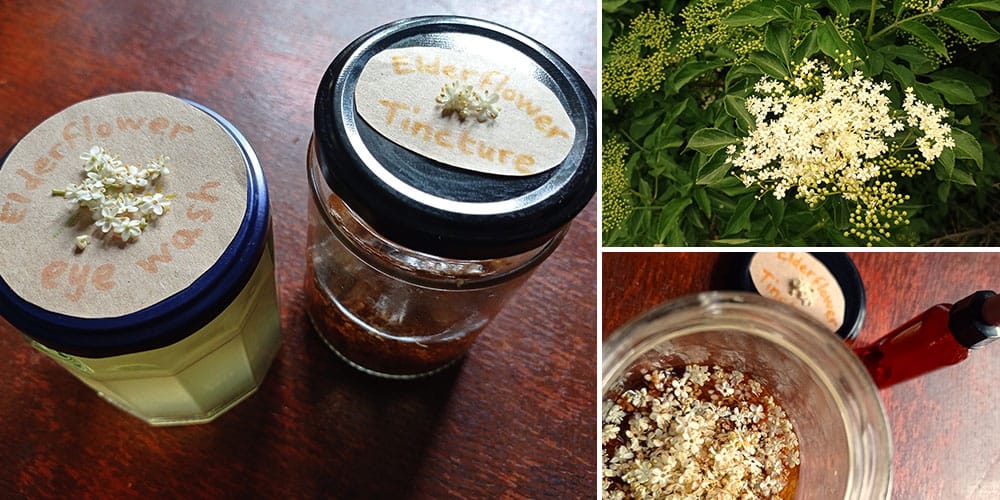
You’d Better Do This If You Have Allergies
Whether it’s pollen allergies affecting your eyes, causing blocked sinuses, or sore throats, these remedies will help you to feel better instantly by sipping infusions, using an eye wash, or taking a few drops of tincture to ease your symptoms.
Hay fever is a reaction to pollen in spring and summer but you can prepare your body in advance by taking Elderflower so you build up defenses naturally.
Elderflower vs Poisonous Lookalikes
Elderflowers bloom in late April or June in some regions, so pick lots, dry some for infusions, make a tincture, and then you can boost yourself before the pollen gets too strong.
However, remember that if you pick all the flowers, there will be no elderberries later in the year and that wildlife is very fond of these flowers and berries too. Pick thoughtfully, in areas that you know haven’t been sprayed, and avoid roadsides.
There are 4 varieties of Elderflower in the US. Sambucus nigra (pictured) grows in the US and Europe; nigra refers to the dark black, hanging berries in the fall. Leaves are oval-shaped, with a pointed top. The tree can grow as tall as 20-30 feet. Other elderflowers have the same scientific name, plus their identifier afterward.
Sambucus canadensis is called American Elderberry and grows in the US and Canada. Blue Elderberry (Sambucus caerulea), has cream-colored blooms in spring with blue fruit in the fall, while a pink-colored Elderflower (Sambucus mexicana) shrub grows in the southwestern states.
To distinguish elderflower (Sambucus nigra) from its poisonous lookalikes, focus on several key features. Elderflower has creamy white, small, star-shaped flowers arranged in flat-topped clusters called umbels. These flowers emit a pleasant, sweet fragrance, which is a distinctive characteristic. The leaves of elderflower are opposite and pinnate, typically with 5-7 serrated leaflets. The stems are soft and green in younger plants, becoming woody as they mature.
Poisonous lookalikes such as hemlock water dropwort (Oenanthe crocata) and giant hogweed (Heracleum mantegazzianum) have notable differences. Hemlock water dropwort has white flowers in more umbrella-shaped clusters and lacks the sweet scent of elderflower. Its leaves are finely divided and feathery.
Giant hogweed features large, umbrella-shaped white flower clusters and can cause severe skin reactions; its leaves are deeply lobed and jagged, and the plant can grow very tall, much larger than elderflower.
Another lookalike, cow parsley (Anthriscus sylvestris), has umbels of small white flowers but lacks the characteristic sweet scent of elderflower. Its leaves are fern-like and finely divided, giving it a more delicate and lacy appearance compared to the broader, serrated leaves of elderflower.
If you’re wondering how I gained such a vast foraging knowledge, it is mostly because of these two wonderful books: The Forager’s Guide to Wild Foods and The Wilderness Long-Term Survival Guide.
Benefits of the Ingredients
These remedies use cream-colored Elderflowers, and all cream-colored Elderflowers can be used. They contain natural antihistamines called quercetin and tannins, that can soothe affected eyes, and help to reduce sinusitis from allergies. They are also used for colds and flu and to reduce fever.
For respiratory support you can also try Nicole’s Allergy & Asthma Support Bundle or this Bronchial Blend Tincture.
Beekeepers have told me that taking a teaspoon of local honey allows your body to taste the local pollens collected by bees before they become active in spring, and this may help you too. Find a local supplier, so you can taste sweet honey and support local suppliers too.
Taking elderflower tincture (or an infusion) early in the year before the pollen gets very strong can help you acclimatize to the allergen before it becomes problematic. So pick enough flowers this year so you can dry some to use in infusions starting in February next year, to help you build up resistance.
DIY Elderflower Eyewash
You will need:
- For large quantities: 2-3 cups of freshly picked elderflowers
- For one infusion: 1 tablespoon of fresh blooms
- Water: 4-6 cups of hot water for larger quantities, or a cupful
- A cup or bowl to mix the ingredients
- A strainer and muslin to remove the petals
- A clean jar or bottle to store it
Steps:
- Cut bunches of elderflowers on a sunny day. They have a distinctive scent, which comes from the pollen so if it has been raining, do not collect flowers that day. Sniff first, and then choose bunches with the small creamy flowers that smell divine.
- Pick the petals from the flowers and drop them into a teacup, or a larger bowl. Exclude the thick green flower stems if possible; only use the creamy petals.

- Pour boiling water on to make the infusion. Allow this to cool for at least an hour.
- Strain the petals using the funnel into a clean container. You can place it in the refrigerator or allow it to cool to room temperature.
 You can store the eyewash in the fridge for up to a week.
You can store the eyewash in the fridge for up to a week.
How to Use
Either soak a clean facecloth in the infusion, and gently wipe the affected eyes, allowing the solution to soak in, or use a small glass (or an egg cup) full of the infusion to rinse your sore eyes. Elderflower has anti-histamine properties and this should bring some soothing relief. I find that doing this causes any blocked sinuses to release at the same time so have some tissues handy!
You could also drink a daily infusion of elderflower to boost the antihistamine response.
DIY Elderflower Tincture
Boiling can destroy a plant’s essential elements but alcohol preserves it and keeps it fresh for longer.
If you have elderflowers in your backyard it helps because you need to pick 3 separate bunches of flowers over the period you make the tincture. You can also use dried flowers. Just increase the alcohol content because fresh flowers will contain some water, whereas dried flowers do not.
You will need:
- 1/3 cup of freshly picked elderflower petals- picked every 7 days to gradually add them to the tincture (a total of 1 cup)
- 2 cups of your chosen spirit alcohol (brandy, vodka)
- A clean jar with a lid to mix the ingredients
- A strainer and muslin to remove the petals
- A clean tincture bottle to store the remedy
Steps:
- Cut bunches of elderflowers on a sunny day. Do not wash the blooms or the scent disappears and you will strain the mixture later anyway.
- Avoid using the thick green stems. Just cut or tear off individual petals from the flowers directly into a clean container.

- Add your chosen alcohol to cover the flowers completely. For quantities, I suggest 1 cup of flowers to 2 cups, or enough alcohol to cover the petals. Put the lid back on and place this in a dark place. Check the jar every few days and gently shake it.

- After 6-7 days, strain the petals, return the same alcohol to the jar, and then add fresh petals, to increase the strength of the remedy. Repeat this step twice, so that you have infused 3 sets of fresh petals in the alcohol. I learned this method from my grandma, but if you find it too complicated, you can fill the jar with fresh petals from the beginning and completely cover with alcohol to infuse.
- Now it’s time to strain the flowers for the last time. Using a funnel and muslin, strain the final mixture carefully into the tincture bottle.
 I prefer a brown shade of bottle to conserve the goodness away from natural light. Store it in a dark cupboard out of direct sunlight. It will keep for up to 2 years.
I prefer a brown shade of bottle to conserve the goodness away from natural light. Store it in a dark cupboard out of direct sunlight. It will keep for up to 2 years.
How to Use
Take 5 drops of the tincture in a small cup of water 2-3 times daily in allergy season. Try not to exceed the quantities because elderflower can have a laxative effect if taken in excess.
Extra Tips
If you have any flowers leftover, don’t waste them! They taste delicious in Elderflower cordial, Elderflower fritters, or both.
The cordial needs 4 cups of elderflower petals with green stems removed, the juice of 2 lemons, a tablespoon of citric acid, 4 cups of sugar, and 4 cups of boiling water. Place all the ingredients in a bowl, pour boiling water to melt the sugar, and stir well. The sugar will conserve the mixture for months if you seal it in a bottle and store in the fridge.
I doubt it will last long in any household! Children love the sweetness diluted with some water as a squash substitute, and you can also use it as a flavoring to pour over ice cream for a spring treat.
To make fritters, just make a pancake mixture, dip the freshly picked flower heads into the mixture, and pop it into a deep-fat fryer or air fryer to cook. Delicious!








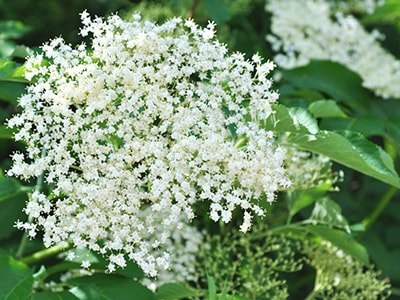
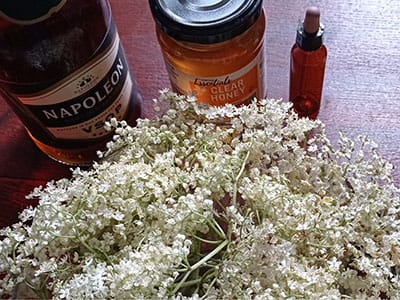
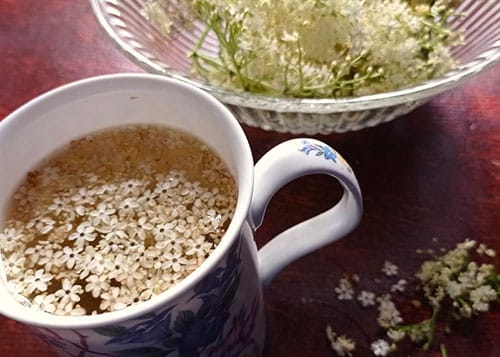
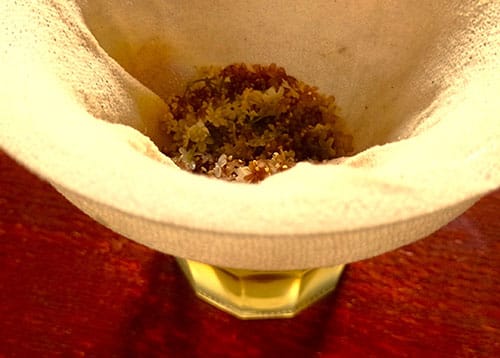 You can store the eyewash in the fridge for up to a week.
You can store the eyewash in the fridge for up to a week.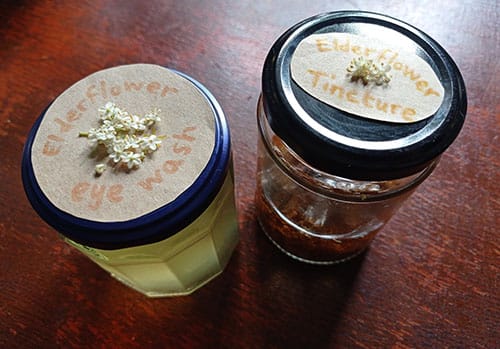
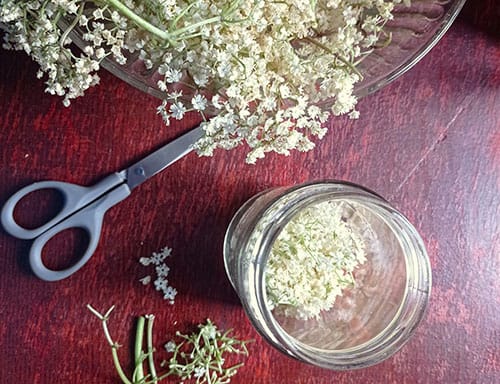

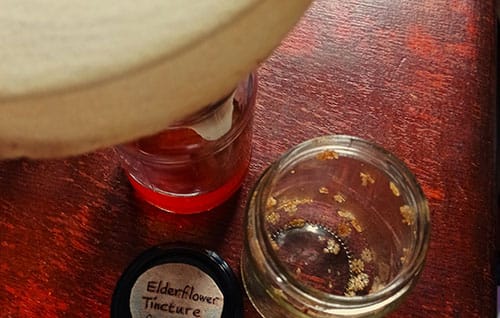 I prefer a brown shade of bottle to conserve the goodness away from natural light. Store it in a dark cupboard out of direct sunlight. It will keep for up to 2 years.
I prefer a brown shade of bottle to conserve the goodness away from natural light. Store it in a dark cupboard out of direct sunlight. It will keep for up to 2 years.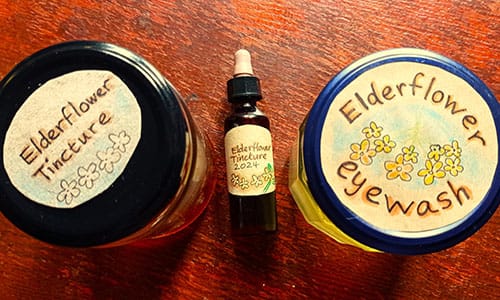
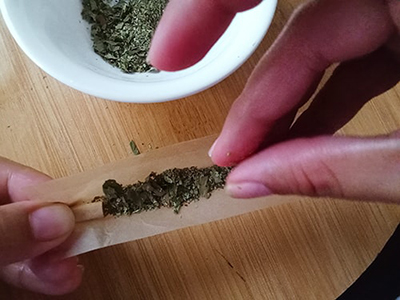
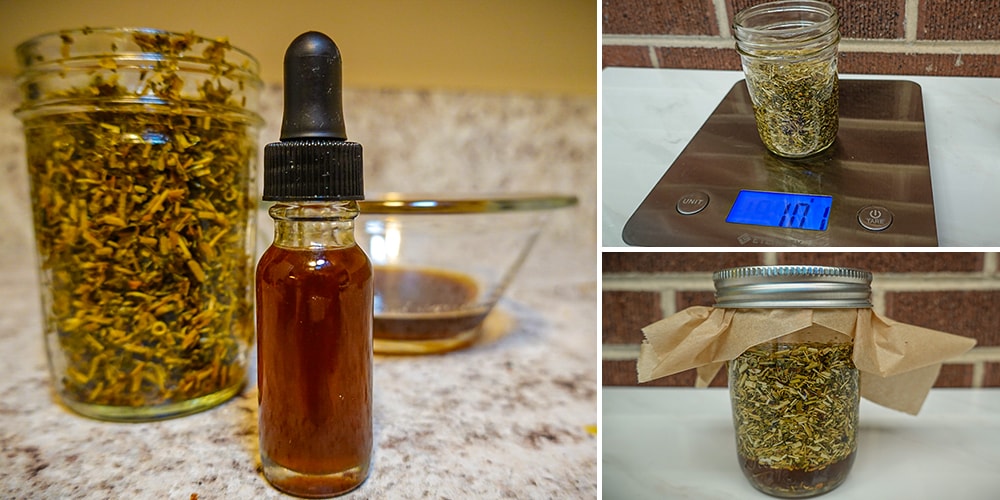
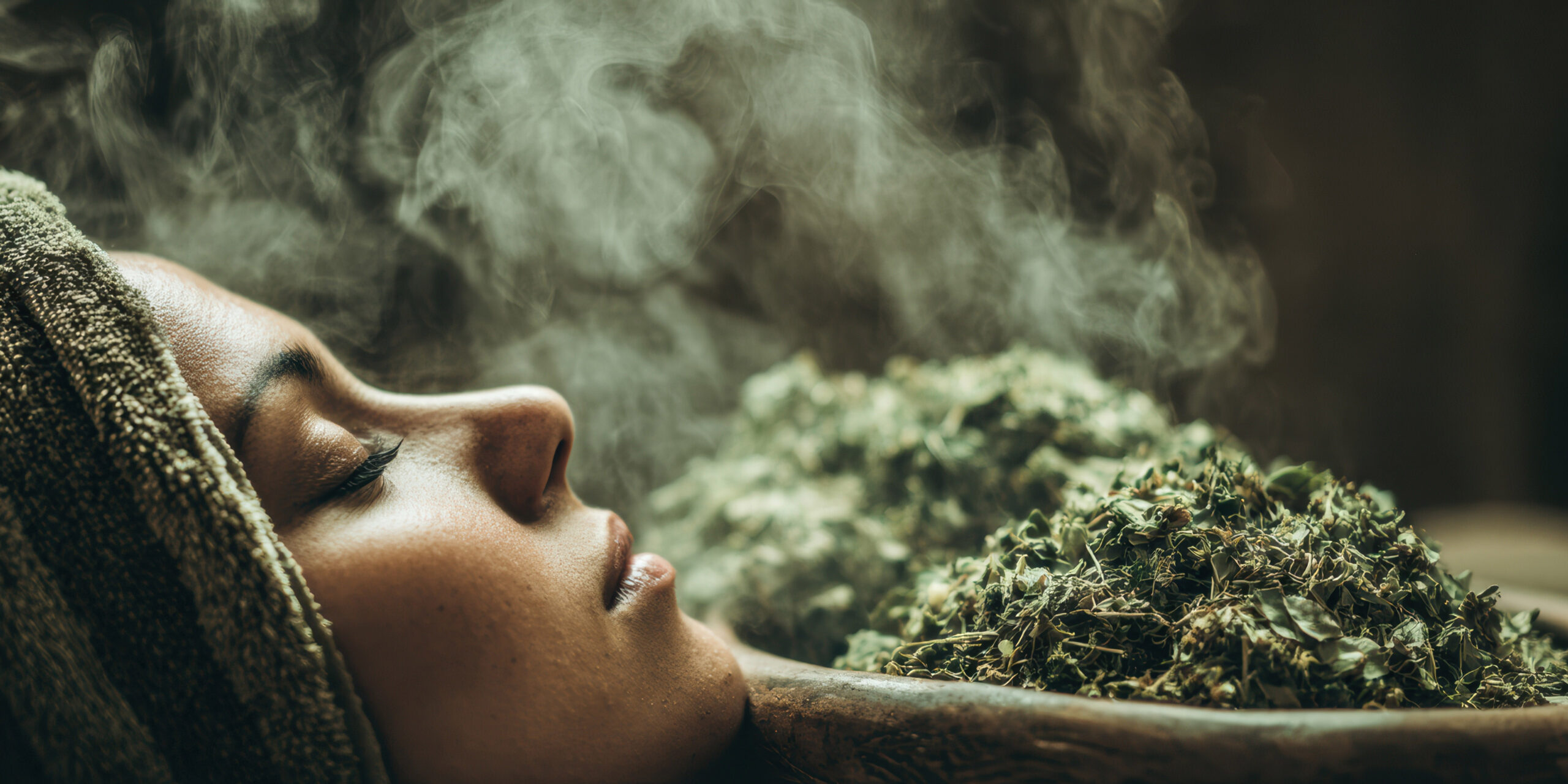
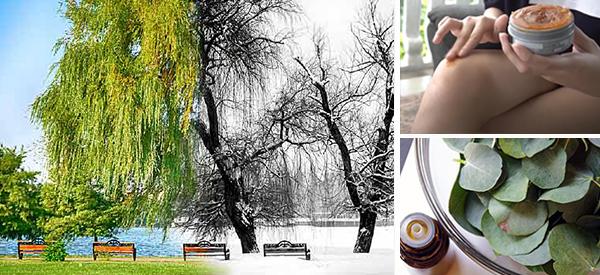
Would I be able to use the dried elderflowers I have in place of the fresh flowers?
That is a good question. I’d like to know.
Hi Wendy,
Thank you for your interest in this recipe!
Yes, dried herbs are even a better choice than fresh. Just make sure to use 1/3 of the amount mentioned by the author.
Many blessings and good health!
Are there any herbs to help me deal with my allergies to chemicals (i.e., multiple chemical sensitivity)? (I’ve never had a problem with hay fever, thankfully, though it might be partly due to the fact that for years I inoculate myself beginning in the fall until spring with a small amount of local honey each day.) Thanks so much for all the wonderful information you post!
Cool, I’m trying it. Hope it works. I have bad allergies.
Hello, I ordered the book in zero 517 2024 and I didn’t receive that you charge my credit card but I didn’t receive the book yet
Hi Petrit,
Thank you for supporting our work!
Please send us an email at support@thelostherbs.com and we will make sure to provide you with all the necessary information regarding your order.
Many blessings and good health!
Im looking for a remidy for shingels
Look up Lysine for shingles
Is there any way to strenthen my nails
My husband brought me your 2 books the Forager’s Guide to Wild Foods and the lost book of herbal remedies. It was awesome and a lot to learn!! Thanks
Can you use this if pregnant? Many thanks 😊
First timer and maybe unenlightened.The Elder-flower produces the Elderberry- same plant? Not similar species? Hey, and just got and am printing the Lost Skills Academy E- books- lots to quiz myself on while learning.